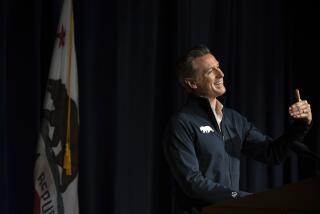Conejo Valley Chamber of Commerce Deep in Debt
- Share via
THOUSAND OAKS — It’s run by and for business owners in one of the state’s most prosperous communities. But the Conejo Valley Chamber of Commerce is knee-deep in red ink.
The chamber recently said it owes about 50 creditors close to $80,000 and is late on nearly $25,000 in mortgage payments on its two-story office building in Thousand Oaks.
Officials said losses began to mount when chamber managers failed to cut expenses as membership--and dues--plummeted during the recession in the early 1990s. Fund-raising problems, including a wine-tasting event that lost $11,000, added to the group’s decline.
For now, creditors are being patient, said Gary Wartik, a chamber member and business consultant who has volunteered to work with the chamber and those waiting for payment--the majority of whom are chamber members.
“We have nobody threatening the chamber,” he said. “Every creditor I’ve talked to has indicated a willingness to work with us.”
One creditor, who asked that he not be identified, said things went sour in the last four months of 1997, when invoices were virtually ignored.
“Phone calls weren’t returned, things like that,” he said. “I guess the jury is still out on whether there is any integrity over there, but it appears to be improving.”
Past mistakes in management are catching up with the chamber, President-elect Larry Carignan said.
“We’re really paying for not having a hands-on approach,” said Carignan, owner of Carignan Construction Co. in Westlake Village.
Before the crisis became apparent, members were told by the board of directors that everything was OK, Carignan said. “We accepted some answers that we should have insisted on some better backup information.”
Chamber President Jerry Gross, who is superintendent of the Conejo Valley Unified School District, said, “It’s time to bite the bullet and do what’s necessary to relieve this problem.
*
“We’ll only become stronger by this,” Gross said. “The board is committed to cutting expenses, and we plan to be out of the woods soon.”
With about 1,050 members who pay an average of $250 a year in dues, the chamber now has an annual budget of about $260,000. At its height, with a membership of 1,600, the chamber had a budget approaching $500,000.
Full-time paid staff has been cut from 14 to six, and two of the remaining positions, including executive director, are being left unfilled to save money.
Fred Burkhardt was relieved of his duties as executive director in December. While chamber officials decline to discuss the circumstances of his departure, the group’s problems were ongoing before he was hired in September 1996, Wartik said.
Chamber officials promise to pay all their bills dating from Jan. 1 while they work out a plan to catch up on missed payments. But the wounds of the debt issue remain, Wartik said.
“We’re working hard to make sure that this doesn’t get any worse, or ever happen again,” he said. “From now on, we need a very clear picture of where the chamber stands so we can act accordingly.”
*
That picture was clouded in recent years as chamber staff failed to react to declining membership caused by businesses closing or relocating, Wartik said. But the chamber continued to count them in budget projections.
“We had a 90-day grace period for renewals, so during those three months we still had some of these businesses down as paying members, but the revenue wasn’t there,” he said. “At times, we were off by 10 to 15%.”
The chamber has moved to a 60-day grace period on dues collection. Members that don’t renew on time must rejoin as a new business.
And by April, the chamber hopes to have a plan to retire its outstanding debt. Proposed steps include refinancing a $432,000 mortgage on the 8-year-old chamber building and scaling back the number of chamber-sponsored events, Wartik said. Officials will now focus on those events that generate a profit.
*
Refinancing the mortgage through Los Robles Bank could decrease monthly payments by at least one-third, which could be used to pay bills from caterers, janitors, landscapers and printers, he said.
The chamber also plans to rent out office space in its building to offset mortgage costs. Several administrative positions will be left vacant to save money, Wartik said.
Carignan said that admitting to past mistakes means more attention is now being focused on the chamber.
“The lesson we’ve learned is that people are going to insist on accountability from our staff and our board,” he said. “It would be easy for someone to say, ‘Who needs this? I quit.’ But that’s not what it’s all about.
“We’re all volunteers who have our own businesses to run, but we’re here to provide an important service to businesses in this community,” Carignan said.
In the late 1980s, business in Thousand Oaks was brisk and the chamber’s membership rolls were at an all-time high of 1,600. As the staff grew, the healthy flow of dues prompted the board to buy the two-story building on Hillcrest Drive.
Then the economy slipped, and membership began to drop.
Other parts of the Southland experienced a similar trend. By 1993, the Northridge Chamber of Commerce had dropped from its high of 600 members in the mid-1980s to 250, and the Los Angeles Area Chamber of Commerce plunged from 4,000 full-time members to 2,000 by 1995.
In the Conejo Valley, the chamber had a choice: hope for the best and keep spending money, or cut back. Chamber leaders chose the more optimistic course, Wartik said.
“The chamber was looking for that proverbial light at the end of the tunnel, and we did not act as quickly as we could have to reduce our expenses,” Wartik said.
According to a Jan. 20 report prepared for creditors, the chamber got itself into trouble around 1995 by using inflated membership numbers while choosing to pay the mortgage at the expense of other creditors.
“With revenues continuing to erode, the burden of meeting debt service on the building became an increasing challenge,” the report stated. “In order to keep current, various program revenues, which might have been used to meet operating expenses, were instead used” for mortgage payments.
*
For the next two years, officials continued to use inflated membership numbers for their projected annual budgets, according to the report.
Then in 1997, the chamber’s annual golf tournament brought in half of the $15,000 officials had projected, and a “Taste of Conejo” wine-tasting event failed miserably, leading to a loss of $11,000.
Poor planning and “holes in the presentation” plagued the wine-tasting event, Carignan said.
“We met with the vendor, and he projected a loss maybe around $2,000,” Carignan said. “We couldn’t back out of it by then so we went ahead, and when it was all said and done, our loss was much greater than expected.”
That’s when the severity of the debt hit, bringing about the current call for change.
*
“As tough as it is to swallow, we’re doing it,” Carignan said. “This community deserves a viable chamber that answers for its actions.”
Chamber member Bob Given, owner of Conejo Graphics in Westlake Village, said he hopes that officials can remedy the situation without increasing dues.
“I’d like to see things get back on track, but I don’t think members want to chip in in a large way,” Given said. “It’s going to be a tough one, and I think they realize it.
“Hopefully we can all gain from this and learn to work together better. That’s what we’re here for,” he said.
More to Read
Sign up for Essential California
The most important California stories and recommendations in your inbox every morning.
You may occasionally receive promotional content from the Los Angeles Times.












